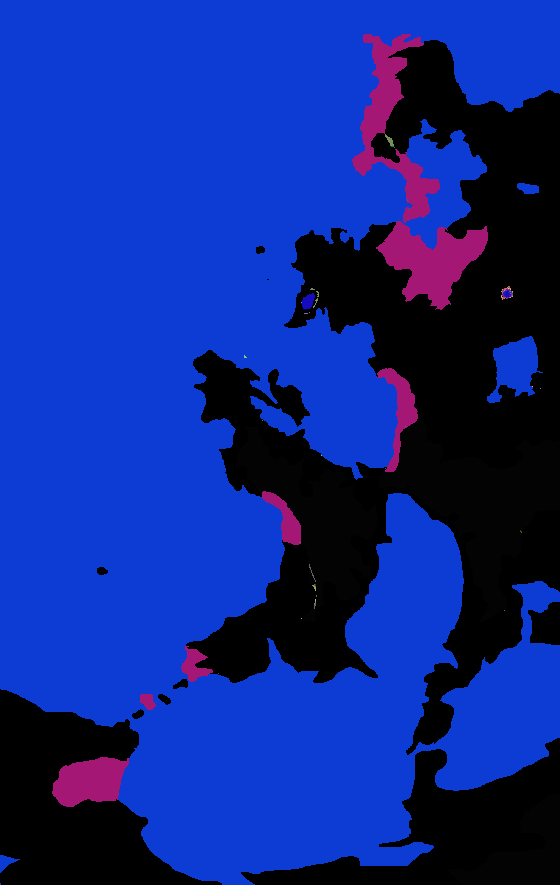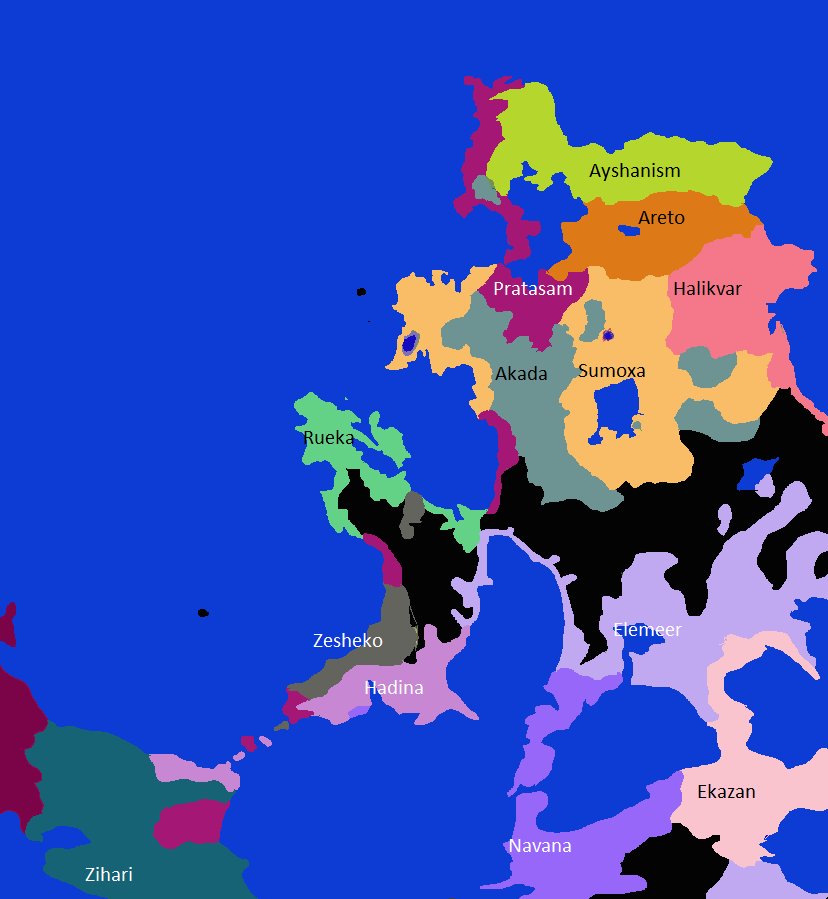The history of Pratasam is incredibly long and deeply intertwined with local politics. Please see the timeline for a more in-depth historical listing.
The Blessed Covenant and the First Schisms
In 1300s DE (in the earliest days of the Architects), the rich and abundant riverlands of Samvara were fiercely contested. Native semi-nomadic human groups heavily intermingled with migrating mixed human-dryad nomads as tribes and peoples of all sorts sought a home on the riverbanks and in the oases. But many critical river junctions were held by the Prism-dominated semi-subterranean cities of early
Akada, who lived sedentary and highly-ordered lives. These cities sought to prevent migration and often subjugated trespassing peoples into forced labor. Desperate nomads hoped to unite against them, but the diverse and distant tribes struggled to find common ground. From their ranks rose a false prophet named
Lily of Red, whose growing success attracted the attention of
Halcyon. Halcyon stepped in and offered her powers of
Druidism if she served the Architects, and she used these powers to unite the river peoples and forge a united identity. The cave cities agreed to keep to themselves and the world was split in two between the surface peoples and those below. The religion of Lily became Suweskivar, the people of the Blessed Covenant. Suweskivar spread across the surface of the continent, but quickly faced internal divisions over who was to follow what religious laws. Halcyon had placed magical restrictions on Alkoa/druids to limit the destruction they could cause with their powers- but should these model the laws of everyday people? Those of Lily's tribe, the Dawara -known now as the
Halikvar- believed so. The other tribes felt that the Halikvar were too extreme and worked to isolate them from the greater whole. The vulnerable Halikvar were attacked by Suewskivari and Akadan invaders alike, and fled Eastward. Those who remained Westward became the Pratasa.
Following the departure of the Halikvari, the Pratasa sought to create a structure for mediating disputes more constructively. They created an annual meeting of the greatest druids, known as the Circle of Archdruids, intended to moderate and mediate the religion. But the Circle focused its attention almost solely on the Southwestern riverlands. As the religion expanded across the continent, many offshoots were neglected by the circle. Infighting began again over what Pratasam truly was and who qualified as a true believer. The greatest divergence were those of the Northeast, who belonged to a totally different religious tradition. They had converted, but kept many of their gods and practices- and their distance from the riverlands had left them largely neglected. For centuries they were ignored but when the Empire of Shenerem emerged and gathered its own Circle of Northern Archdruids in the 32 ME the riverlands entered a rage. In 50 ME, the Circle of Archdruids of Pratasam officially exiled the souls of the Shenerem Archdruids to Hell, and crafted a careful definition of what Pratasam was. Interestingly, it was largely based on belief rather than ritual- though they belief had to be backed up by devotion and identity. The Northeastern Archdruids remained their own separate offshoot for centuries, and despite brief a communion in 302 ME and a "pact of peaceful coexistence and reintegration" made in 736 ME, the Eastern temple only drifted further and further. In 1105, the Eastern temple officially declared itself entirely independent of either Halikvar or Pratasam, and embraced its identity as its own religion. It is now known as
Areto.
The Lunar Crisis
While Lily of Red holds a position of immense honor in Pratasam, she was proven fallible and limited by the failures of her descendants- her age is over. This didn't stop her from trying to seize control of the Pratasa religion in the 400s, 500s, 600s, and 700s ME. It began with a pact made in 410 ME with the prodigy druid Bashaba, who swore they would serve Lily for life in exchange for knowledge and power. Bashaba a powerful and influential Elder Druid as they rose in the ranks, and through them Lily was able to secure power over the ruling and priestly classes of the powerful riverlands kingdom of Swemet. Lily aggressively backed Swemet, which rose as an empire and asserted her will on the council of Archdruids. But as Lily's influence rose, her opposition grew. Other Lunar gods began intervening with other Elder Druids, and coalitions against Swemet took on a religious aspect as well as a political one. War swept across Pratasam as the Gods fought for control. Even worse, the Gods seemed to appeal to and trust their species over others- and fear began to spread that the Lunar Gods would destroy the fragile species-equality that Pratasam kept. Excessive loyalty to only one faction of Lunar Gods became taboo among many sects, and the other Lunar Gods united to back this movement - to both undo the damage they had done and to deny Lily her empire.
Ultimately, Lily struggled to keep permanent control of any region or faction other than Swemet- and empires cannot last forever. As the empire declined in infighting and corruption, Lily seized direct control of Swemet in 698 ME. The isolated empire lashed out in a series of terrible wars against other Elder Druids and against the
Akada empires that supported them. In 726, a failed campaign against the under-empires led to Swemet losing its army. In 730, it had completely fallen, and Lily's dream was crushed.
The Lunar Crisis represented both the start of anti-Lunar-Cult attitudes in Pratasam and the end of any hope of reuniting with Halikvar (and to a lesser extent, Areto). While Lily's primary goal was power, her grand vision was the reuniting of the three temples into one religion with a clear doctrine and authority.
The War of Three Circles
After the Circle of Archdruids rejected the guidance of the Lunar Pantheon in shaping their doctrine and authority, they were left to try and create a permanent system themselves. Unsurprisingly, no one could agree on the best system- but two priestly factions emerged. These factions remain the primary divide in Pratasam today, as they have taken many forms and many names. Here, their many manifestations will be referred to under the umbrella terms of
Prikia and
Eteza. Prikia is the faction of tradition and decentralization. They see ritual and tradition as the ultimate manifestation of enlightenment, with belief and technical definitions of truth being less important. Prikia priests see the meetings of elder priests as the ultimate form of discussion between equals and the only form of true authority. Eteza disagrees. The Eteza faction is the faction of order and truth. They see ritual as a way to reinforce belief, but not important in itself. Etezan priests typically support a constant Circle of Archdruids ruling over the faithful to police dogma and guide the faithful as a whole.
While the early Etezans were better organized and more powerful within the religion, they suffered from constant infighting. Where would this permanent ruling Circle be located, how would it be organized, who would it represent and who would it leave out? These questions dominated most discussions, leaving the Etezans virtually motionless for centuries. But while the priests were stuck in eternal debate, the monarchs acted. While the fall of Swemet had left the riverlands region (that of
Empria) divided, it had sown the seeds for several significant successors. From 800 to 920, one kingdom seemed destined to unite the riverlands entirely: the Kingdom of Emiet, which crowned itself the Empire of Empria in 905. The Kingdom of Emiet supported the Etezans and envisioned itself as the leader of Pratasam: and its rise to power deeply worried many of the other Pratasa kingdoms. After Emiet lost its war against the rising Selkie Empire, the surrounding lands piled on to dismantle it. But while they managed to butcher the imperial family of Emiet in 910 ME, their efforts to destroy the kingdom were cut short by selkie intervention. It seemed certain that Empria would collapse back into feuding minor kingdoms- but the Etezan druids felt otherwise. The most powerful of them, Elder Druid Kanita, seized direct control. Offering to supply the Selkie empire with troops, they were able to court selkie support and establish absolute control over all of Empria. Kanita tried several times to find a good royal family to take over the actual administration, but ultimately crowned herself empress in 920 ME. Her royal line quickly died out, but the Etezan faction was greatly emboldened and they seized direct control of the government in 980 ME. They formed their own permanent Circle of Archdruids and demanded all Elder Druids of Pratasam bow to the rightful rulers of the True Faith.
The Declaration of Supremacy of 980 threw Pratasam back into civil religious war. Empria was again invaded from its surrounding kingdoms, but everywhere factions of Etezans and Prikia fought one another for dominance. In 982, a faction of mostly-Prikia druid-priests that had organized to end a brutal civil war in the Kingdom of Maruva (known originally as the White Dove Movement) used their organization to turn against the Declaration of Supremacy and make their own Circle of Archdruids that issued its own Declaration of Supremacy. In 984, a separate group of Etezans that agreed with the idea of a permanent Circle but felt that the Emprians were unfairly excluding non-riverlands priests formed their own Circle of Archdruids in the Northwest with its own Declaration of Supremacy. The three circles battled for dominance in a three-way religious war from 980 ME to 1040 ME. The wars began to wind down after the Etezans factions agreed on a compromise in 1032 and united against the Prikians- invading Maruva and destroying the White Dove Circle in 1040. But even after the wars wound down, Prikian and Etezan clerics and nobles fought each other on-and-off for decades. Prikian priests finally accepted the Circle's authority and joined the greater druidic assembly in 1150, with some stragglers fighting on until 1200.
The Druidic Revolution
While the Circle's authority was unanimously recognized in 1200, the infighting never truly stopped. The questions of who would be represented and who was
truly Pratasa remained only partially answered. The Prikian compromise allowed for Elder Druids to largely manage their own affairs, and the Etezan compromise placed the Circle in an island that was de-facto Selkie territory. Many felt that the Circle needed to be doing more: everywhere, the enemies of the faithful grew in power and numbers.
In 1300, that discontent boiled over in what is now known as the Druidic Revolution. It began as a political movement in Empria to overthrow the monarchy and to give power to a group of young druids and scholars. But its success in Empria turned into a challenge against the Circle, demanding action and representation. The small, cautious, and conservative clique of ruling druids was seen as out of touch, illegitimate, corrupt, and unfair. In 1302, the Revolution spread out of Empria and seized control of the Circle Headquarters. Several archdruids even joined the revolutionaries, seizing unilateral control of the circle.
From 1302 to 1320, the revolutionary factions fought for control before the old imperial family returned to retake their throne. The divided and weakened revolutionaries lost control over Empria and by 1400 most theocratic revolutionary movements had faded in enthusiasm. The revolution may have been a failure in creating Utopian governments, but it did radicalize the Circle, increase its powers, and introduce the representation of lower priests. From 1310 onwards, Pratasam became more aggressive and evangelical. Efforts to invade lands devoted to
Ayshanism and the foreign lands of
Garadel increased dramatically. Policing of Pratasam cultural norms and dogma also increased dramatically. All of this expansion and aggression came at a cost- notably, the loss of the
Rueka faith, which formally splintered from the radical revolutionary definitions of Pratasam in 1302 and never returned to the fold.





Comments